Wu Yao-cheng (吳要城), 84, holds up a white porcelain bowl to the window in his studio home in Yingge District (鶯歌), New Taipei City. On the inside, it is painted with auspicious symbols; on the outside, there is a scene of monkeys. Wu didn’t paint it: his specialty is making the eggshell porcelain (薄胎瓷) bodies. Held to the light, you can clearly see the symbols through the thin porcelain, superimposed upon the monkey scene.
The Taipei Times is at Wu’s home with ceramic artist Wang Shu-ling (王淑玲). Wang, who has been working with ceramics for 20 years, is currently focusing on ink brush painting on pure white porcelain, and regularly commissions Wu to make the thin hand-thrown porcelains she needs for her work. When he retires, she will have to move in a new direction: she knows of no one else in Taiwan with Wu’s skill set.
Porcelain clay is fiendishly difficult to work with, says Wang, and nowadays porcelain bodies are produced using molds and slip casting, as results are easily replicable and with a much higher success rate. She says it is impossible to master throwing porcelain — and in particular, achieving eggshell porcelain — in a short time.
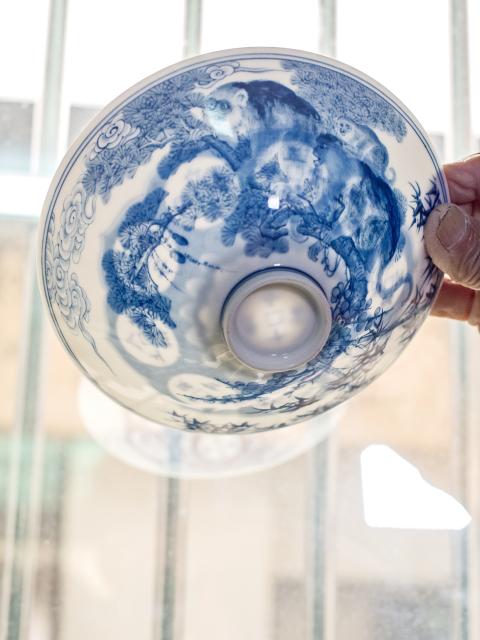
Photo: Paul Cooper, Taipei Times
“It’s like mastering the violin or the cello. It’s something that you have to work at for eight hours every day for 10 years,” Wang says.
Wu has been doing it for 70 years.
He mastered the skill as a small child in China, and has worked in Yingge since he left the army in 1973. According to Cheng Wen-hung (程文宏), head of the Educational Promotion Department of the New Taipei City Yingge Ceramics Museum, he was a pioneer of these techniques when he first arrived in Yingge, and is still one of very few, maybe the only one, still capable of producing eggshell porcelains with traditional techniques in Taiwan. When he dies, the tradition will probably die with him.
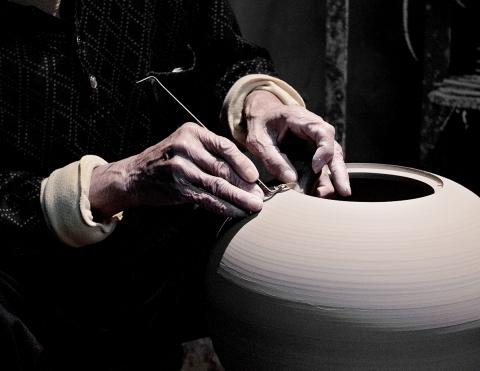
Photo: Paul Cooper, Taipei Times
THE OLD COUNTRY
Wu was born in 1932 to a family of potters going back at least three generations, in Chaozhou (潮州), Guangdong, a city with a tradition of porcelain production dating back to the Song dynasty. He was a boy of 11 when the Japanese invaded his town, Fengxi (楓溪鎮), during the Second Sino-Japanese War.
His family fled to Dapu (大埔), another town in the same province, where his father got work and accommodation in a local ceramics factory.
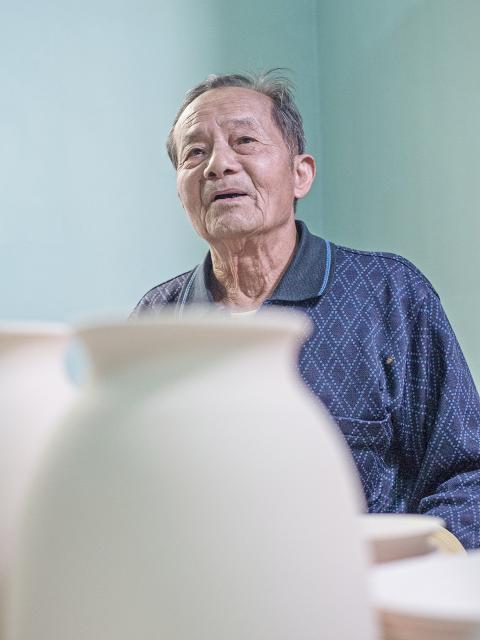
Photo: Paul Cooper, Taipei Times
Wu started helping to produce ceramics at the age of 12. The factory produced functional wares, but some of the more highly skilled workers were also making imitations of sought-after Song, Ming and Qing dynasty ceramics, including eggshell porcelains, on commission. He would observe them during the day and practice on his own after work. In two years he had mastered the fundamentals of the technique.
“You can’t do that unless you are gifted,” says Wang.
THE PROBLEM WITH PORCELAIN
Porcelain is prized for its translucent, sonorous quality, and the pure white that cannot be achieved with the lower-fired earthenware or stoneware clays. But every step of the process demands excellent technique.
Wang says that unlike other clays, porcelain clay has no “bone,” or structure, making it very difficult to throw.
But achieving the extreme thinness for eggshell pieces also requires manually trimming the unfired porcelain pieces with steel trimming blades, on a rapidly rotating potter’s wheel. This means the artisan has to be totally familiar with the exact cross-section, throughout the entire piece. Otherwise, he will trim it down to nothing.
“He has to know every form intimately. There is absolutely no room for error,” Wang says.
The unfired, trimmed body is extremely fragile, and must be fired with the correct technique, too.
“Generally speaking, you have to fire things yourself. If you get other people to fire them for you, they may well break,” Wu says.
ARRIVING IN YINGGE
Wu came to Taiwan at the end of World War II with the Chinese Nationalist Party (KMT) army. He left the army in 1973 and found work with Tsai Hsiao-fang (蔡曉芳), now based in Beitou District (北投), who has made a name for himself producing high-fired imitations of ancient Chinese ceramics.
Tsai took him to the National Palace Museum to look at the ancient ceramics from the Song, Ming and Qing dynasties, and asked him if he could make them.
“I specialized in throwing, working there from 1974 to 1980. I made a lot of porcelain bodies for [Tsai],” Wu says. In 1980, he felt it was time to strike out on his own.
He made a success of producing his own wares in a factory, but when it was sold after two years he moved operations into his house, which of course was not set up to fire a kiln to 1,300 degrees Celsius. He has focused on making eggshell porcelain bodies on commission since 1983, and now lets other people worry about the success or failure of the other steps of the process.
“If they fire it well, then they get the money, and if they don’t, then it’s a problem with their technique,” he shrugs, before offering, “although I will give them advice on how to do it.”
Wu is still going strong, and says he has no plans to retire. But he cannot go on forever, and when he stops, there is no one to replace him. Will the loss of this skill have a huge impact on ceramic art in Yingge? Probably not. But for some — Wang included — it will be a huge loss.
Yingge Town Artisan is a monthly photographic and historical exploration of the artists and potters linked to New Taipei City’s Yingge Town.
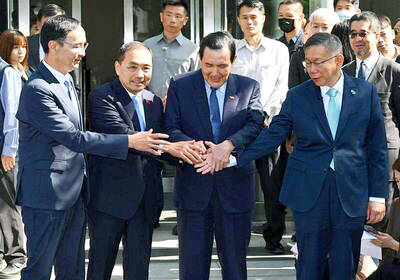
Has the Taiwan People’s Party (TPP) changed under the leadership of Huang Kuo-chang (黃國昌)? In tone and messaging, it obviously has, but this is largely driven by events over the past year. How much is surface noise, and how much is substance? How differently party founder Ko Wen-je (柯文哲) would have handled these events is impossible to determine because the biggest event was Ko’s own arrest on multiple corruption charges and being jailed incommunicado. To understand the similarities and differences that may be evolving in the Huang era, we must first understand Ko’s TPP. ELECTORAL STRATEGY The party’s strategy under Ko was
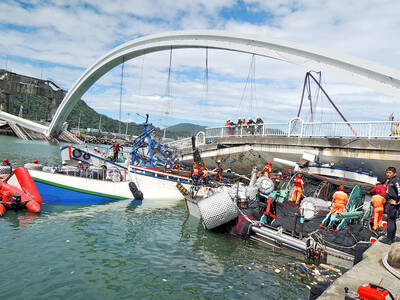
Before the recall election drowned out other news, CNN last month became the latest in a long line of media organs to report on abuses of migrant workers in Taiwan’s fishing fleet. After a brief flare of interest, the news media moved on. The migrant worker issues, however, did not. CNN’s stinging title, “Taiwan is held up as a bastion of liberal values. But migrant workers report abuse, injury and death in its fishing industry,” was widely quoted, including by the Fisheries Agency in its response. It obviously hurt. The Fisheries Agency was not slow to convey a classic government

It’s Aug. 8, Father’s Day in Taiwan. I asked a Chinese chatbot a simple question: “How is Father’s Day celebrated in Taiwan and China?” The answer was as ideological as it was unexpected. The AI said Taiwan is “a region” (地區) and “a province of China” (中國的省份). It then adopted the collective pronoun “we” to praise the holiday in the voice of the “Chinese government,” saying Father’s Day aligns with “core socialist values” of the “Chinese nation.” The chatbot was DeepSeek, the fastest growing app ever to reach 100 million users (in seven days!) and one of the world’s most advanced and
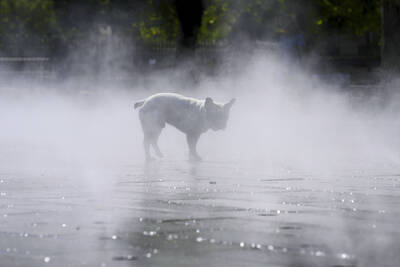
It turns out many Americans aren’t great at identifying which personal decisions contribute most to climate change. A study recently published by the National Academy of Sciences found that when asked to rank actions, such as swapping a car that uses gasoline for an electric one, carpooling or reducing food waste, participants weren’t very accurate when assessing how much those actions contributed to climate change, which is caused mostly by the release of greenhouse gases that happen when fuels like gasoline, oil and coal are burned. “People over-assign impact to actually pretty low-impact actions such as recycling, and underestimate the actual carbon